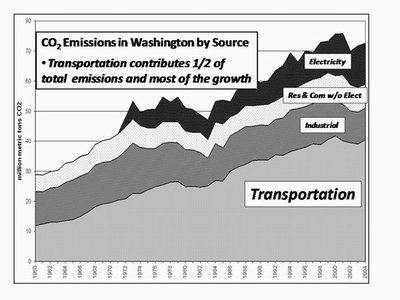August 20, 2009
Washington forests may be solution to state’s green-energy quest
Wood is a popular fuel for heating homes in the Northwest but few people might see it as an important source of liquid fuels for motor vehicles. However, a new University of Washington report commissioned by the Washington Legislature suggests that woody biomass could represent the state’s greatest opportunity to develop biofuels and reduce both green house gas emissions and dependency upon imported oil.
The report by the UW’s School of Forest Resources further concludes that the state’s biomass would best be used for transportation fuel as opposed to using it to generate electricity.
Woody biomass has three key advantages — all of which should be weighed no matter which alternative energy source is being evaluated, the report authors say. They are:
• Sustainability — For energy production, there has to be enough material on a continuous basis, according to Larry Mason, a researcher in forest resources and lead author of the study. Washington ranks at the top of U.S. states in woody biomass availability, with one-twentieth of the nation’s inventoried woody biomass. The term woody biomass refers to the residues left after harvesting trees or manufacturing wood products, the spindly material thinned from forests to reduce risk of wildfires and trees such as cottonwoods grown on plantations. Eleven million dry tons of forest biomass are potentially available annually in the state for energy production, which amounts to two-thirds of the state’s available biomass. Woody biomass supplies could also be augmented with agricultural residues and municipal solid waste.
• Energy independence — Washington has low electricity rates, generates the cleanest electricity in the nation and produces so much electricity that it is exported to other states. At the same time the state is 100 percent reliant on oil imported from other states or abroad. Biomass is by far the most abundant and sustainably available state resource that can be converted into liquid fuels to replace gasoline and diesel. Producing transportation fuels from state biomass resources is the pathway toward greater energy independence, the report says.
• Climate change mitigation — Another reason to focus on using woody biomass to produce transportation fuel is that half of the carbon dioxide generated in the state comes from transportation. Emissions from transportation dwarf the carbon dioxide released by the production of electricity in Washington. Unlike fossil fuel alternatives, biofuels from wood are considered to be carbon neutral.
In light of these three considerations, state incentives and regulations that encourage generating electrical power from renewable sources such as woody biomass should be examined, says John Calhoun, director of the Olympic Natural Resources Center and a study co-author.
“While wood residue may currently be considered waste,” Calhoun says, “Washington must not squander this renewable resource by misdirecting its use if we want to meet our state goals of sustainability, energy independence and climate change mitigation. Woody biomass is the only renewable, clean resource available in Washington that can make a significant contribution toward our energy policy goals.”
Another advantage of woody biomass is what’s already in place, says Mason. The state’s largest biomass process and delivery system is the forest industry. Pulp and paper mills represent the single largest industrial capital investment in renewable energy development. Liquid fuels conversions from woody biomass will require large integrated facilities, such as pulp and paper mills, that, with new investment, could maximize conversion efficiencies and reduce capital and operating costs while producing a steady flow of paper and energy products.
“Co-location with state pulp and paper mills to capture synergies with existing infrastructure represents the greatest single opportunity for bioenergy development. Such mills already have transportation and handling capabilities, a highly-skilled workforce, adequate water supplies and water treatment plants,” Mason says.
The report “Wood to Energy in Washington; Imperatives, Opportunities, and Obstacles to Progress” is available at http://tinyurl.com/o6esrw. Other co-authors are Richard Gustafson and Bruce Lippke, both professors of forest resources, and Natalia Raffaeli, graduate student.
###
For more information:
Mason, cell 206-300-4491, larrym@u.washington.edu
Calhoun, available now by cell 360-461-3127, on e-mail again after Aug. 25 jcalhoun@u.washington.edu
Gustafson, 206-543-2790, pulp@u.washington.edu


